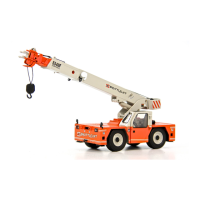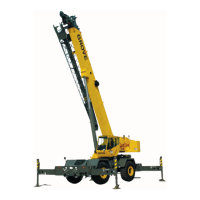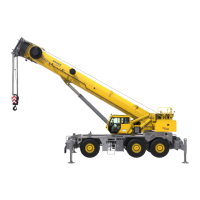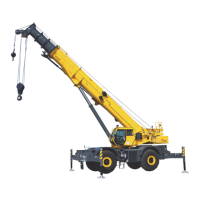2-67
TMS800E SERVICE MANUAL HYDRAULIC SYSTEM
Published 01-29-2014, Control # 496-00
STEER CYLINDER
Description
The steer cylinders (see Figure 2-48) are mounted on the
front axles. The steer cylinders each have 5.08 cm (2.0 in)
diameter bores. The steer cylinders each have a retracted
length of 52.15 cm (20.53 in) from end to end. The steer
cylinders each have an extended length of 82.63 cm (32.53
in) from end to end. Each cylinder has a stroke of 30.48 cm
(12.0 in). A wiper ring prevents foreign material from entering
each cylinder. O-rings and other seals prevent internal and
external leakage.
The cylinder weighs approximately 6.0 kg (13.2 lb).
Maintenance
Disassembly
NOTE: Any maintenance requiring disassembly of the
cylinder should include replacement of all cylinder
seals.
1. Secure the cylinder in a clean work area by use of
clamps or a chain vise to prevent rolling.
2. Retract the cylinder fully to avoid damaging the rod
during removal.
NOTE: Mark or note the piston and head relationship to the
rod and barrel.
3. Clean away all dirt from the head. Place protective
padding around the rod near the head to prevent
damaging the chrome during head removal.
4. Position the rod mount with the ports facing down.
5. Using a means of collecting the oil, remove the port
plugs and allow cylinder to drain.
6. Rapidly pull the rod against the head to free it. Remove
rod and attached parts from the barrel. Place the rod on
a surface that will not damage the chrome or allow the
rod assembly to drop.
NOTE: Cover the barrel opening to avoid contamination.
7. Remove the seal from the outside of the piston.
NOTE: Arranging discarded seals and rings in the order of
disassembly will aid in installation of new seals and
rings. Pay attention to how each seal and ring is
installed to avoid installing replacement seals and
rings improperly.
8. Loosen and remove the nut securing the piston.
Remove the piston from the rod.
9. Remove the O-ring from the inside of the piston.
10. Remove the head from the rod. Remove the O-ring and
backup ring from the outside of the head. Remove the
wiper ring and the rod seal from the inside of the head.
CAUTION
Do not use air pressure to remove the rod. Use only a
source of controlled hydraulic oil pressure if the rod is
hard to remove.
CAUTION
Exercise extreme care when handling or setting down the
rod. Damage to the rod surface may cause unnecessary
maintenance and expense.
CAUTION
When removing seals and rings, avoid scratching the
grooved and gland surfaces.
Reference Only
